|
1. I've entered my vehicle registration number and the tyre size shown is not the one fitted to my vehicle?
Our tyre size data is provided by matching DVLA data to tyre size data from the SMMT (Society of Motor Manufacturers and Traders) to identify the tyres fitted to your vehicle as original equipment. Sometimes cars are fitted with upgraded wheels/tyres so we recommend that you always take a moment to double-check the tyre size actually fitted to your car before making a booking.
2. I've entered my vehicle registration number and my car doesn't come up?
Double check that you've entered the correct details e.g. entering letter O in place of a zero. Whilst we do have data for many Light Commercial Vehicles we can't always guarantee this. Unfortunately we do not currently offer motorcycle tyres, but there are other specialist fitting centres that can. Also, if you have recently transferred a personalised number plate it can take the DVLA a few weeks to update their database.
If your vehicle's details are substantially incorrect you should contact the DVLA.
Alternatively simply enter your tyre size e.g. 205 55 16 and speed rating for a full list of available tyres.
3. I'm not sure how to read my tyre size from my tyre?
Please see the diagram below or if you have any further questions, please call us on 01204 650 760 or drop in as we are local.
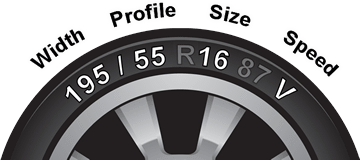
4. I've ordered the wrong tyre size by mistake what do I do?
Whilst we will do our best to help, it is your responsibility to check that the tyre size you have selected for fitting to your vehicle is correct. If you are concerned about this you should contact us as soon as possible on 01204 650 760.
If you forget what tyre you've booked you can always check your confirmation email or call us on 01204 650 760 and we'll quickly check our records for your booking details.
5. Do the prices quoted include fitting?
Our prices are for fully fitted tyres and include a new valve, wheel balancing and casing disposal.
6. I've made a booking for fitting, but have not received an e-mail confirmation?
Please check that your spam filter hasn't caught the email and then you can always contact us on 01204 650 760 and we will e-mail a copy of your confirmation to you.
7. Can I amend my booking?
If you want to amend your booking please notify us as soon as possible by telephone on 01204 650 760.
8. Can I get my tyres fitted earlier?
We always try to offer a fast and responsive service, which is why we have developed this on line booking system. However, if you require a fitting date sooner than the dates offered on the site, call on 01204 650 760 and we'll do our best to bring your booking date forward if stock is available.
9. When do I pay for my tyres?
This website allows you to select tyres for your vehicle and then book a convenient time for fitting. You only have to make a payment to us at the fitting centre when you are completely happy.
10. Can I get additional work, such as wheel alignment, when I get my tyres fitted?
We provide a number of related services. All you have to do is add your service requirement to the comment box when submitting your booking. You can also use the link on your confirmation email.
11. What is EU Tyre Labelling About
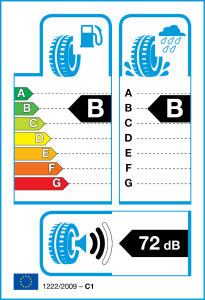 |
To reduce the impact tyres have on the environment and to promote road safety, a new EU regulation came into force on 1 November 2012 that is designed to make it easier for motorists to compare different tyres. From this date all new tyres for cars, vans, 4x4 and most trucks have to display a standard format label that indicates three key aspects of a tyre; fuel efficiency, wet grip performance and external rolling noise. Similar in style to energy labels for white goods, these labels provide comparable information about a tyre regardless of the brand or tread pattern. By using clear pictograms, the label allows motorists to make informed choices when buying tyres, ranked on a scale from A (best) to G (worst). Certain types of tyre, such as; T-type temporary use tyres, off-road tyres, racing tyres, vintage car tyres and retread tyres are excluded from this regulation. |
12. Tyre Labelling in More Detail
a. Fuel Efficiency
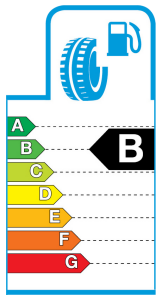 |
Tyres are responsible for between 20 and 30% of a vehicle's fuel consumption. As a tyre rolls it uses energy and so a tyre that has a lower rolling resistance will use less energy and this has a direct impact on fuel efficiency and CO2 emissions. Choosing tyres ranked A (best) over tyres ranked G (worst) can reduce fuel consumption by up to 7.5%. This equates to a typical annual fuel saving of 120 litres or £168 (based on 12000 miles and £1.4/l). Currently D is not used on the scale to provide a clear distinction between higher and less efficient tyres. |
b. Wet Grip Performance
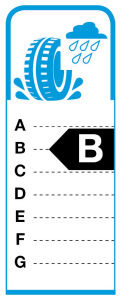 |
Wet grip performance is one of the most important safety characteristics of a tyre. Tyres with good wet grip have shorter braking distances on wet roads. Two types of test are used to measure a tyres grip when braking from 50mph in wet conditions. Results are combined and ranked from A (best) to G (worst) and, like with fuel efficiency, grade D is not used to help more easily distinguish between tyres with shorter and longer braking distances. Each grade equates to a difference in braking distance of approximately 3 meters. Therefore fitting tyres ranked A over those ranked G can reduce braking distance in the wet by 18 meters, which clearly could help avert a road traffic accident. |
c. External Rolling Noise
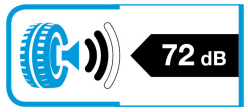 |
The inclusion of external rolling noise as a key aspect of a tyre's performance is to encourage motorists to buy low noise tyres and thereby reduce noise pollution. A microphone measures the rolling noise of a car travelling at 50mph with the engine turned off and the results, in decibels, are given for each tyre. In addition 'black sound waves' are used to indicate quieter tyres (1 black sound wave) in comparison to noisier tyres (3 black sound waves). Currently 3 black sound waves is the legal limit, 2 will be a new lower limit to come into effect sometime by 2016 and 1 black sound wave is 3 decibels below this future lower limit. Three decibels may not seem a lot, but it is effectively halving the noise level. |
|